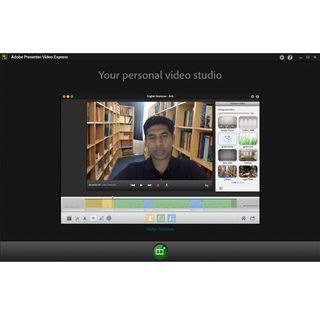

In Figure 3, PVX immediately completed capturing everything from my shoulders to the top of my head. At this point, I used the mouse to draw the horizontal line across my shoulders that you see in Figure 2. The dashed line (marquee or mouse tracks) appeared around my head, partially selecting my face and neck as soon as I let go of the mouse. In Figure 2, I’ve already drawn a vertical line with my mouse from the top of my head to the bottom of the screen. The process is just that simple, and it’s very fast. After that, you can put whatever you want in the background, including a still image, a video, or a motion graphic. Then use your mouse to draw a line from the top of your head to the bottom of the screen and a second line across your shoulders. All you have to do is click on the bottom of the screen where it says “Make my background awesome” and it takes a snapshot. It doesn’t matter whether you are in front of a blank wall or plain fabric, or even a mostly blank office wall, no matter the color of the wall or fabric, PVX can extract you.

You can make “green screen” video anywhere.Īdobe’s engineers wrote a brilliant algorithm that will make your work look like network TV. All you need is a blank wall and a webcam. You need some expertise to use it, mostly in lighting, but it also requires good post-production skills. As I mentioned earlier, green screen, even in a studio, is not the easiest thing to use.

In eLearning, we never seem to have enough time or budget for video production. You can do the same things with PVX that you can do with a regular green screen setup, but without all the fussiness. The first (and most important) thing Presenter Video Express (PVX) does is to eliminate the need for green screen production. Presenter Video Express is an amazing new program on several levels, both in concept and in execution. There was no way to change what was behind your head. But that was about all it did when it was part of Adobe Presenter. It’s a standalone version of the video part of Adobe Presenter that allows you to capture directly into PowerPoint from your laptop video camera. This is one program I’ve seen in the last several months that totally exceeded my expectations, and continues to do so. Featuresīut I cannot ignore Adobe Presenter Video Express. Most offer little in the way of new features. They're mostly a rehash of what I've seen or used. I’ve looked at a lot of “new” video- and audio-related software. From this screen you can either continue working on a past project (the smaller box in the upper left of the bigger box) or you can start a new project by using the big green button. In this case the power is under the hood, so to speak.
#Adobe presenter video express imported video software
You might imagine that this is a simple piece of software however, this isn’t the whole story. A little box inside a big box and one big green button at the bottom center of the screen. Here’s the opening screen for Adobe Presenter Video Express (Figure 1).įigure 1: Presenter Video Express opening screen In this article, I will offer you a working review of Adobe Presenter Video Express, the latest software solution for the kinds of problems I mentioned in the first paragraph. You don’t need all that equipment, and software can take care of almost all the rest. Don’t believe me? Google “green screen techniques for video and photography.” Green screen is a technique that requires careful planning and setup, careful lighting, a certain amount of the right equipment, and a lot of know-how and tweaking.

After that, use video technology to put that actor’s image on top of the background you want.īut it isn’t that simple. Sounds simple, doesn’t it? Put your actor in front of a green background (the “green screen”), then just use video technology to capture an image of your actor (without any of the green background). This is how your television weatherman appears in front of a big weather map or radar display. The classic answer to these questions is “chromakey,” otherwise known as “green screen” (or “blue screen”-different name and color but the same principles are involved). What do you do when you have to shoot on location and your actor can’t be there? What if the “location” where the action will happen only exists in your mind? How can you superimpose an actor onto a still photo or a video as a background?


 0 kommentar(er)
0 kommentar(er)
